 Technology peripherals
Technology peripherals
 AI
AI
 Top AI researchers, China contributes 26%: Global Talent Think Tank report released
Top AI researchers, China contributes 26%: Global Talent Think Tank report released
Top AI researchers, China contributes 26%: Global Talent Think Tank report released
In 2019, "MIT Technology Review" reported a report on the growth rate of China's artificial intelligence talent pool. The main findings of the report are very interesting: In the past decade, the number of elite artificial intelligence scholars from China has increased tenfold, but relatively few people stay in China to work.
This week, a report revealed new analysis from the think tank behind it, showing how the makeup of the global AI talent pool has changed since then – during this critical period. The artificial intelligence industry has undergone a major transformation and has become the hottest technology field.
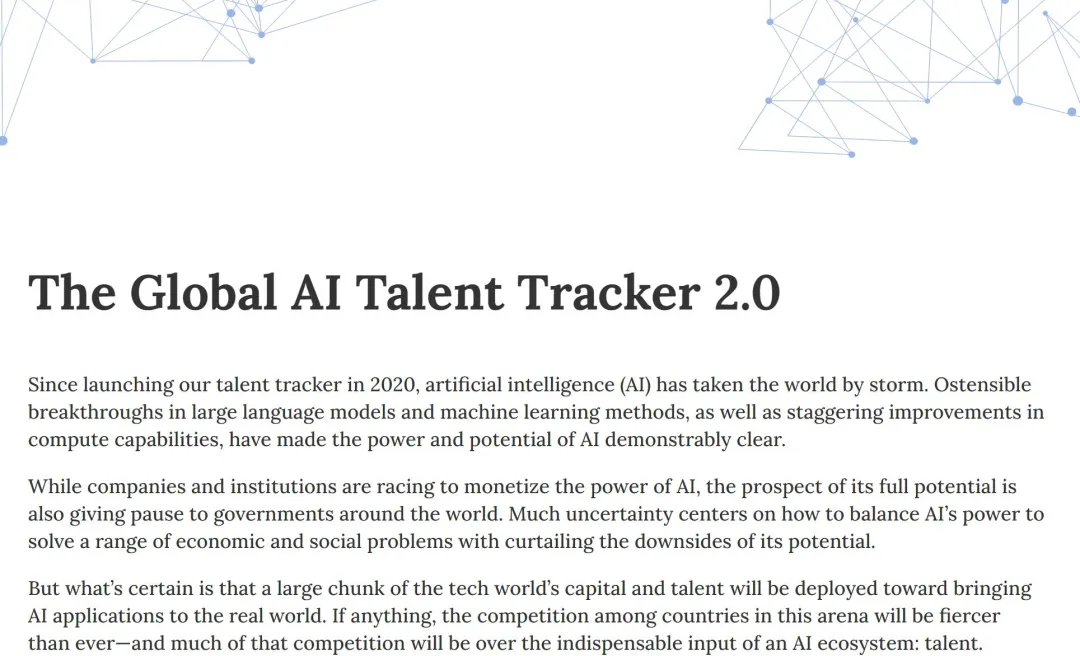
Artificial intelligence (AI) has penetrated into every corner of the world. The rapid development of large-scale language models and machine learning methods, as well as the amazing improvements in computing hardware, have increased the capabilities of artificial intelligence to the level of "promoting a new round of industrial revolution."
It can be foreseen that a large amount of capital and talents in the technology community will be used to implement artificial intelligence applications. Competition among countries in the field of AI will be more intense than ever, and much of the competition will revolve around an indispensable input to the AI ecosystem: talent.
The "Global Artificial Intelligence Talent Tracking Survey Report 2.0" released by the MacroPolo think tank under the Paulson Institute (Paulson Institute) in the United States clarifies the top Global distribution and mobility of artificial intelligence researchers and scientists.
In order to make an apples-to-apples comparison, this 2023 updated version (2.0), like the 1.0 version, uses NeurIPS, the top conference in the field of artificial intelligence, as a sample. At the December 2022 meeting, NeurIPS accepted a record 2671 papers, an acceptance rate of 25.6%, compared with 1428 papers in 2019, an acceptance rate of 21.6%.
Judging from the number of participants, submission scale and popularity, NeurIPS is one of the most representative artificial intelligence conferences, which also means that it is very suitable for Analyzing the top (top 20%) artificial intelligence research talent. We chose to focus on top talent because we believe top talent are most likely to play a leading role in research breakthroughs and establishing new applications in commercial fields.
"Global Artificial Intelligence Talent Tracking Survey Report 2.0" covers the following points:
In the United States, intelligent talents are still the first choice for top talents destination. Among U.S. institutions, U.S. and Chinese researchers (based on undergraduate degrees) account for 75% of top talent in intelligence, up from 58% in 2019. Additionally, the U.S. remains the leading workplace for elite AI talent (top 2%) and hosts 60% of top AI institutions.
2. In addition to the United States and China, the United Kingdom and South Korea, as well as Europe, have slightly increased their share as work destinations for top artificial intelligence researchers. In terms of sources of artificial intelligence researchers (based on undergraduate degrees), India and Canada have seen a relative decline.
3. China has expanded its AI talent pool in the past few years to meet the growing demand for AI industry. With China producing a significant proportion of the world’s top AI researchers (rising from 29% in 2019 to 47% in 2022), it’s no surprise that more Chinese talent is working in domestic industries.
4. A similar situation seems to be happening in India. While India remains a significant exporter of top AI researchers, its ability to retain talent is growing. In 2019, almost all Indian AI researchers (based on undergraduate degree) chose to pursue opportunities abroad. But by 2022, one in five Indian AI researchers ended up working in India.
5. These trends in China and India appear to reflect a broader pattern over the past few years: Top AI researchers have generally shown lower mobility. In 2022, only 42% of top AI researchers are foreigners currently working in other countries, down 13 percentage points from 2019, meaning more of the top talent will stay in their home countries.
The report uses 8 charts to intuitively and clearly describe the career development paths of top artificial intelligence researchers.
1. Where the most elite AI researchers (top ~2%) choose to work:
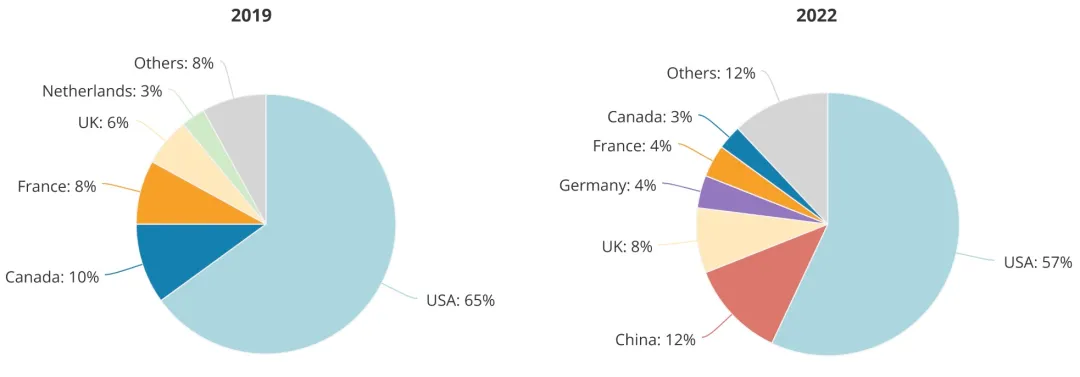
"The most elite artificial intelligence researchers" are defined here as the authors of papers selected for NeurIPS oral presentations, representing the most prestigious paper category. The acceptance rate for oral presentations in 2022 is 1.8%.
2. Primary countries of origin of the most elite AI researchers (top 2%, based on undergraduate degree)
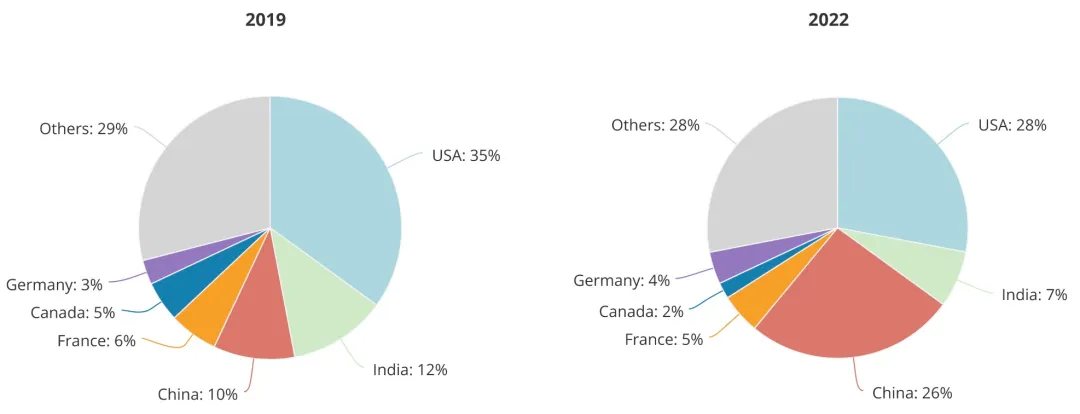
It can be seen that the number of top AI talents in China and the United States is now very close.
3. Top 25 top artificial intelligence research institutions
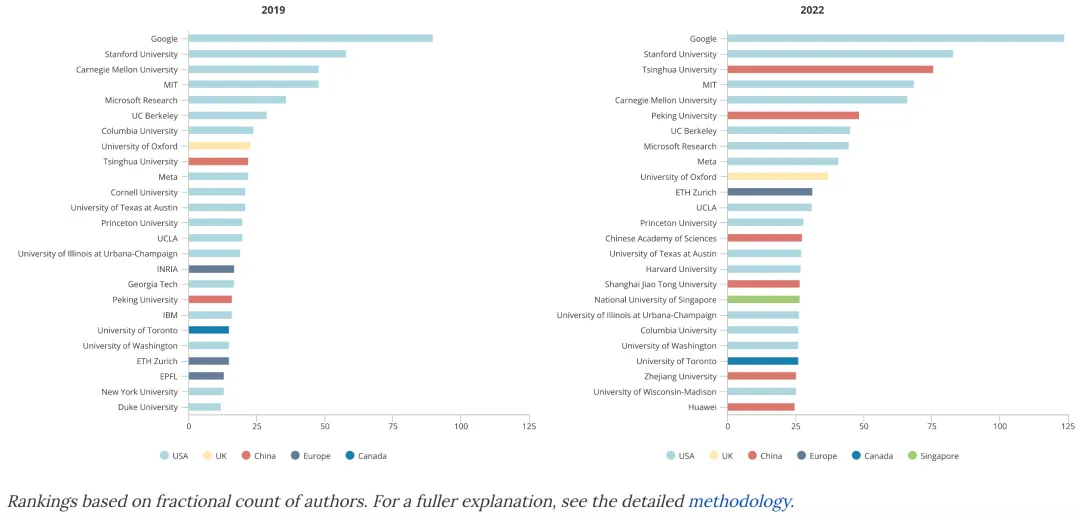
It can be seen that Tsinghua University and Peking University have Entered the top ten.
4. Top countries of origin of top AI researchers (top 20%) working at U.S. institutions
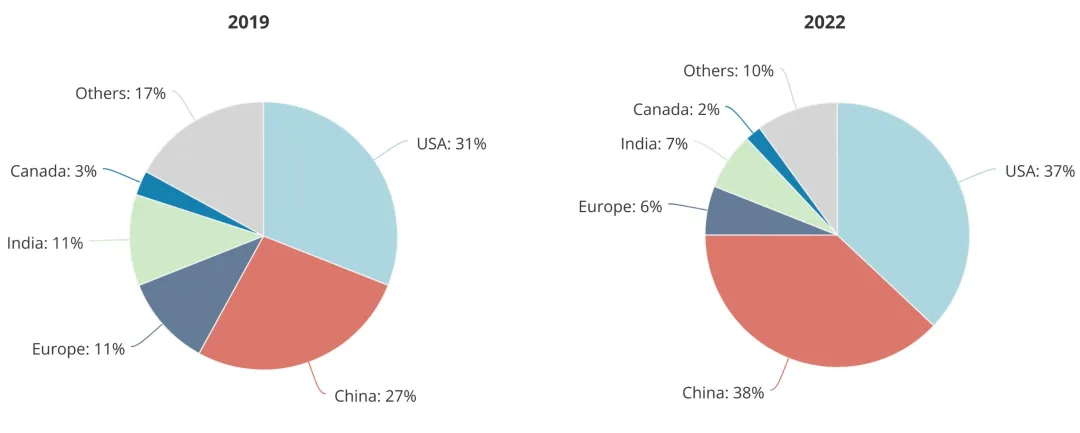
The combined proportion of Chinese and American researchers is larger than in the past, accounting for 75% in total.
5. Country of origin of top AI researchers (top 20%, based on undergraduate degree)
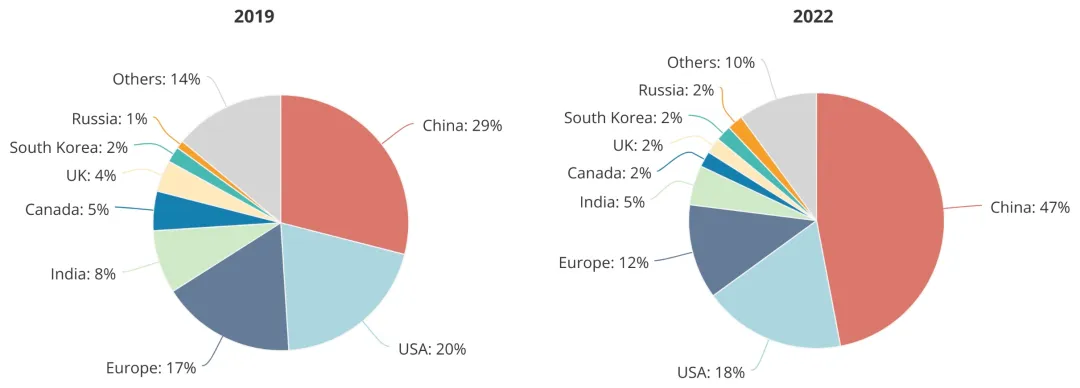
6. The country where the top researchers (top 20%) currently work are headquartered:
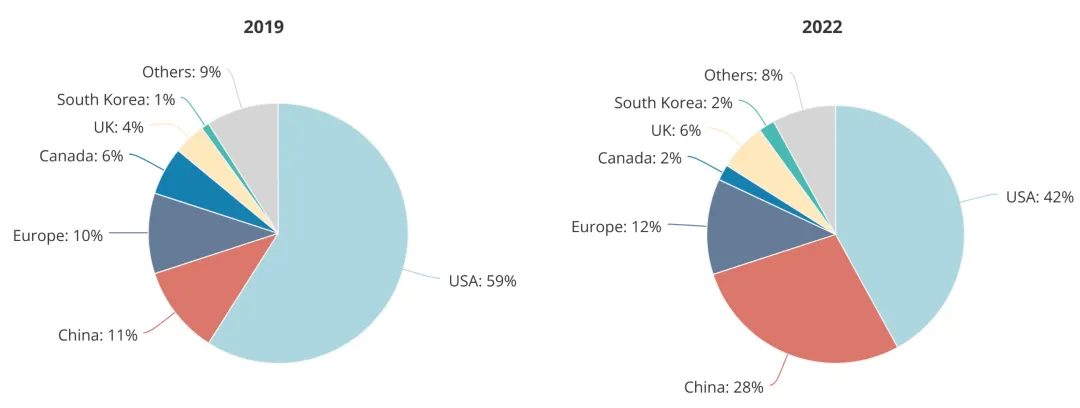
It can be seen that the current United States Institutions and companies are still the main destination for talent, but China and Europe are becoming more attractive.
7. The ratio of some top artificial intelligence researchers (top 20%) working abroad to staying at home
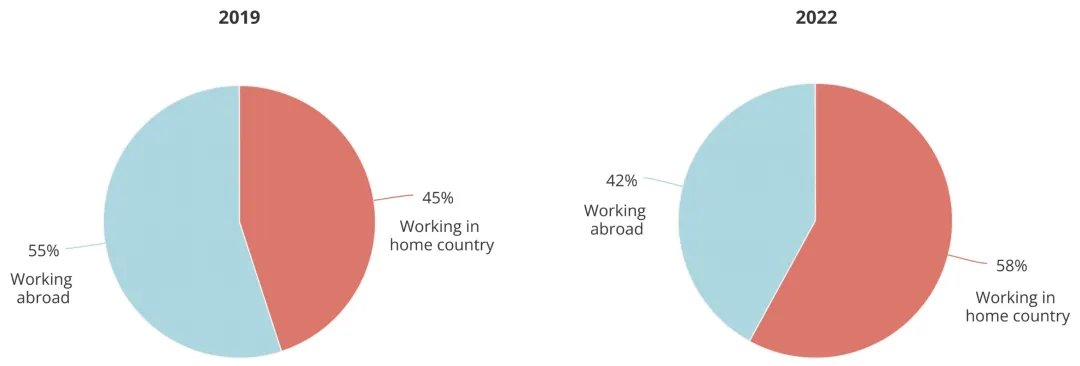
8. After completing their PhDs in the United States, the vast majority of non-American artificial intelligence talents stay in the United States

This number is very intuitive : Nearly 80% of scholars studying for doctoral degrees in the United States will stay and work in the United States. In addition, the report also pointed out that 90% of AI-related professional scholars who graduated in China will stay in China.
It can be seen that in terms of training and introduction of AI talents, the United States still attracts the most talents with an overwhelming advantage, but China is catching up.
The above is the detailed content of Top AI researchers, China contributes 26%: Global Talent Think Tank report released. For more information, please follow other related articles on the PHP Chinese website!

Hot AI Tools

Undress AI Tool
Undress images for free

Undresser.AI Undress
AI-powered app for creating realistic nude photos

AI Clothes Remover
Online AI tool for removing clothes from photos.

Clothoff.io
AI clothes remover

Video Face Swap
Swap faces in any video effortlessly with our completely free AI face swap tool!

Hot Article

Hot Tools

Notepad++7.3.1
Easy-to-use and free code editor

SublimeText3 Chinese version
Chinese version, very easy to use

Zend Studio 13.0.1
Powerful PHP integrated development environment

Dreamweaver CS6
Visual web development tools

SublimeText3 Mac version
God-level code editing software (SublimeText3)
 LINK price breaks through 24 USD Key Resistance Analysis: Chainlink Project Fundamentals and Price Trends
Aug 16, 2025 pm 12:15 PM
LINK price breaks through 24 USD Key Resistance Analysis: Chainlink Project Fundamentals and Price Trends
Aug 16, 2025 pm 12:15 PM
Contents: Current price trend and key technical signals to drive LINK up core factors whale and institutional funds strong entry strategic reserve mechanism strengthens deflation expectations Traditional financial giants adopt accelerated ecological expansion project fundamentals: dominating the real world assets (RWA) tokenization wave price forecast: short-term momentum and long-term potential Summary of current price trends and key technical signals Resistance and support level: If today effectively breaks through $24.64, LINK's next target is Fibonacci 0.786 retracement level 26.46, which may challenge the 2024 high of $30.93 after the breakthrough. Key support
 What is Render (RNDR Coin)? What is the price? 2025 - 2030s Coin Price Forecast
Aug 16, 2025 pm 12:30 PM
What is Render (RNDR Coin)? What is the price? 2025 - 2030s Coin Price Forecast
Aug 16, 2025 pm 12:30 PM
What is Render? Blockchain reshapes the graphics rendering ecosystem Render is a decentralized GPU rendering network built on blockchain technology, committed to breaking the resource concentration pattern in the traditional graphics rendering field. It efficiently connects the supply and demand parties of the global computing power supply and demand through smart contract mechanisms: content creators (such as film production companies, game development teams, AI labs, etc.): they can submit complex rendering tasks on the platform and pay for them with RNDR tokens; computing power providers (individuals or institutions with idle GPUs): they contribute computing power through access to the network and receive RNDR token rewards after completing the tasks. This model effectively solves multiple bottlenecks in traditional rendering processes: Cost optimization: leveraging global distributed computing power funds
 Cryptocurrency IDO platform top5
Aug 21, 2025 pm 07:33 PM
Cryptocurrency IDO platform top5
Aug 21, 2025 pm 07:33 PM
The best IDO platforms in 2025 are pump.fun, Bounce, Coin Terminal, Avalaunch and Gate Launchpad, which are suitable for Meme coin speculation, community-driven auctions, high-return pursuits, Avalanche ecological investment and fair participation of novices. The choice needs to combine investment goals, risk tolerance and project preferences, and focus on platform review and security.
 What exactly is token? What is the difference between token and Coin
Aug 16, 2025 pm 12:33 PM
What exactly is token? What is the difference between token and Coin
Aug 16, 2025 pm 12:33 PM
Coin is a native asset of its own blockchain, such as BTC and ETH, used to pay fees and incentivize networks; tokens are created based on existing blockchains (such as Ethereum) through smart contracts, representing assets, permissions or services, and relying on the host chain to operate, such as UNI and LINK, and transaction fees must be paid with ETH.
 Altcoin bull market momentum strengthens, Bitcoin stagnates
Aug 16, 2025 pm 12:48 PM
Altcoin bull market momentum strengthens, Bitcoin stagnates
Aug 16, 2025 pm 12:48 PM
The crypto market has seen a subtle twist this week. Bitcoin fell into consolidation around about $119,000, with volatility narrowing, while most mainstream altcoins showed a strong rebound momentum. This differentiation has attracted widespread attention: Does it indicate that funds are shifting from Bitcoin to altcoins, and the altcoin rotation market has quietly started? Although Bitcoin still firmly controls market dominance, the Altseason Index has quietly rebounded, releasing potential changes. Altcoins have generally risen, and Bitcoin has accumulated sideways and has seen significant changes in the market structure recently. Bitcoin's market dominance has declined to 58.54%, down 5.32% in 24 hours, while Ether
 What is Polkadot (DOT currency)? Future development and price forecast of DOT
Aug 21, 2025 pm 07:30 PM
What is Polkadot (DOT currency)? Future development and price forecast of DOT
Aug 21, 2025 pm 07:30 PM
What is the directory DOT (Poker Coin)? The origin of Polkadot DOT (Polkadot) The operating principle of Polkadot has 5 major features, aiming to establish the Polkadot ecosystem (Ecosystem) 1. Interoperability 2. Scalability 3. Community Autonomy 4. No Fork Upgrade 5. NPOS Consensus Protocol Polkadot Key Features DOT Ecosystem Polkadot Vision: Connecting Everything Polkadot's Future Development Polkadot Price Forecast Polkadot 2025 Price Forecast Polkadot 2026-203
 The most complete currency nouns on the entire network that novices need to know - must read by Xiaobai
Aug 16, 2025 pm 12:21 PM
The most complete currency nouns on the entire network that novices need to know - must read by Xiaobai
Aug 16, 2025 pm 12:21 PM
The answer is that you need to master basic terms when entering the currency circle for the first time. The article introduces mainstream exchanges such as Binance, Ouyi, and Huobi in 2025, and explains the difference between centralized and decentralized exchanges. Then, it systematically explains the core concepts such as blockchain, cryptocurrency, Bitcoin, Ethereum, altcoins, stablecoins, as well as account security knowledge such as public keys, private keys, mnemonics, and covers market terms such as bull markets, bear markets, HODL, K-lines, FOMO, and FUD, and briefly describes technical concepts such as mining, consensus mechanisms, smart contracts, DApps and Gas fees, to help novices fully understand the coin circle.
 What is Token
Aug 16, 2025 pm 12:39 PM
What is Token
Aug 16, 2025 pm 12:39 PM
Tokens are digital assets on blockchains that represent equity or value. They can be divided into payment, utility, securities, stablecoins and NFTs, etc., for value storage, exchange, governance, rewards, access and collateral. They are issued on chains such as Ethereum through smart contracts, and are created on ERC-20 standards. They can be traded on centralized or decentralized exchanges and stored in hot storage (such as MetaMask) or cold storage (such as Ledger), but face risks such as price fluctuations, supervision, technology, projects, liquidity and security, and should be treated with caution.






